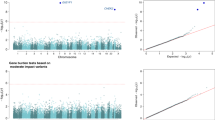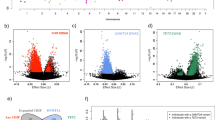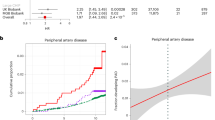Abstract
Large chromosomal clonal mosaic events (CMEs) have been suggested to be linked to aging1,2,3 and to predict cancer2,3. Type 2 diabetes (T2D) has been conceptualized as an accelerated-aging disease4,5,6 and is associated with higher prevalence of cancers7,8,9,10,11. Here we aimed to assess the association between T2D and CME occurrence in blood. We evaluated the presence of CMEs in 7,659 individuals (including 2,208 with T2D) using DNA arrays. A significant association between CME occurrence and T2D was found (odds ratio (OR) = 5.3; P = 5.1 × 10−5) and was stronger when we only considered non-obese individuals with T2D (OR = 5.6; P = 4.9 × 10−5). Notably, CME carriers with T2D had higher prevalence of vascular complications than non-carriers with T2D (71.4% versus 37.1%, respectively; P = 7.7 × 10−4). In CME carriers, we found an increase in the percentage of abnormal cells over 6 years (P = 8.60 × 10−3). In conclusion, given the increased risk of cancer in CME carriers2,3, our results may have profound clinical implications in patients with severe T2D.
This is a preview of subscription content, access via your institution
Access options
Subscribe to this journal
Receive 12 print issues and online access
$209.00 per year
only $17.42 per issue
Buy this article
- Purchase on SpringerLink
- Instant access to full article PDF
Prices may be subject to local taxes which are calculated during checkout

Similar content being viewed by others
References
Forsberg, L.A. et al. Age-related somatic structural changes in the nuclear genome of human blood cells. Am. J. Hum. Genet. 90, 217–228 (2012).
Jacobs, K.B. et al. Detectable clonal mosaicism and its relationship to aging and cancer. Nat. Genet. 44, 651–658 (2012).
Laurie, C.C. et al. Detectable clonal mosaicism from birth to old age and its relationship to cancer. Nat. Genet. 44, 642–650 (2012).
Morley, J.E. Diabetes and aging: epidemiologic overview. Clin. Geriatr. Med. 24, 395–405 (2008).
Curtis, R., Geesaman, B.J. & DiStefano, P.S. Ageing and metabolism: drug discovery opportunities. Nat. Rev. Drug Discov. 4, 569–580 (2005).
Geesaman, B.J. Genetics of aging: implications for drug discovery and development. Am. J. Clin. Nutr. 83, 466S–469S (2006).
Campbell, P.T. et al. Diabetes and cause-specific mortality in a prospective cohort of one million U.S. adults. Diabetes Care 35, 835–844 (2012).
Cohen, D.H. & Leroith, D. Obesity, type 2 diabetes and cancer: the insulin and insulin-like growth factor connection. Endocr. Relat. Cancer 19, F27–F45 (2012).
Johnson, J.A. et al. Diabetes and cancer (1): evaluating the temporal relationship between type 2 diabetes and cancer incidence. Diabetologia 55, 1607–1618 (2012).
Renehan, A.G. et al. Diabetes and cancer (2): evaluating the impact of diabetes on mortality in patients with cancer. Diabetologia 55, 1619–1632 (2012).
Castillo, J.J. et al. Increased incidence of non-Hodgkin lymphoma, leukemia, and myeloma in patients with diabetes mellitus type 2: a meta-analysis of observational studies. Blood 119, 4845–4850 (2012).
Youssoufian, H. & Pyeritz, R.E. Mechanisms and consequences of somatic mosaicism in humans. Nat. Rev. Genet. 3, 748–758 (2002).
Dumanski, J.P. & Piotrowski, A. Structural genetic variation in the context of somatic mosaicism. Methods Mol. Biol. 838, 249–272 (2012).
Pawlikowska, L. et al. Association of common genetic variation in the insulin/IGF1 signaling pathway with human longevity. Aging Cell 8, 460–472 (2009).
Voight, B.F. et al. The metabochip, a custom genotyping array for genetic studies of metabolic, cardiovascular, and anthropometric traits. PLoS Genet. 8, e1002793 (2012).
Martin, L.J. et al. A quantitative trait locus influencing type 2 diabetes susceptibility maps to a region on 5q in an extended French family. Diabetes 51, 3568–3572 (2002).
Sladek, R. et al. A genome-wide association study identifies novel risk loci for type 2 diabetes. Nature 445, 881–885 (2007).
Balkau, B. An epidemiologic survey from a network of French Health Examination Centres, (D.E.S.I.R.): epidemiologic data on the insulin resistance syndrome. Rev. Epidemiol. Sante Publique 44, 373–375 (1996).
Meyre, D. et al. A genome-wide scan for childhood obesity–associated traits in French families shows significant linkage on chromosome 6q22.31-q23.2. Diabetes 53, 803–811 (2004).
Murphy, N. et al. Dietary fibre intake and risks of cancers of the colon and rectum in the European prospective investigation into cancer and nutrition (EPIC). PLoS ONE 7, e39361 (2012).
ADA. Diabetes care standards, guidelines, and related documents. Diabetes Care 32 (suppl. 1), S1–S2 (2009).
Staaf, J. et al. Normalization of Illumina Infinium whole-genome SNP data improves copy number estimates and allelic intensity ratios. BMC Bioinformatics 9, 409 (2008).
Diskin, S.J. et al. Adjustment of genomic waves in signal intensities from whole-genome SNP genotyping platforms. Nucleic Acids Res. 36, e126 (2008).
Peiffer, D.A. et al. High-resolution genomic profiling of chromosomal aberrations using Infinium whole-genome genotyping. Genome Res. 16, 1136–1148 (2006).
Rodríguez-Santiago, B. et al. Mosaic uniparental disomies and aneuploidies as large structural variants of the human genome. Am. J. Hum. Genet. 87, 129–138 (2010).
Acknowledgements
We are sincerely indebted to all participants in the genetic study. We thank M. Deweirder and F. Allegaert for their technical assistance and their invaluable management of DNA samples. This study was supported by the Contrat de Projets Etat–Région Nord-Pas-De-Calais (CPER Axe Cardio-Diabète to P.F.), the Délégation Régionale à la Recherche et à la Technologie de la Région Nord-Pas-De-Calais (DRRT), the European Union (Fonds Européen de Développement Régional (FEDER)) and the Centre National de la Recherche Scientifique (CNRS).
Author information
Authors and Affiliations
Contributions
A.B. and P.F. designed the study and wrote the manuscript. B.S. and L.Y. performed the statistical analyses (CME detection and association analyses) and contributed to writing the manuscript. A.B. contributed to the statistical analyses. S.L. and E.E. performed the genotyping. D.T. contributed to the genotyping. S.C., O.L., B.B., E.R., M.M., G.C. and P.F. contributed to cohort study samples and researched data. All authors approved and commented on the manuscript.
Corresponding author
Ethics declarations
Competing interests
The authors declare no competing financial interests.
Supplementary information
Supplementary Text and Figures
Supplementary Figures 1–4 and Supplementary Table 1 (PDF 4201 kb)
Rights and permissions
About this article
Cite this article
Bonnefond, A., Skrobek, B., Lobbens, S. et al. Association between large detectable clonal mosaicism and type 2 diabetes with vascular complications. Nat Genet 45, 1040–1043 (2013). https://doi.org/10.1038/ng.2700
Received:
Accepted:
Published:
Issue Date:
DOI: https://doi.org/10.1038/ng.2700



